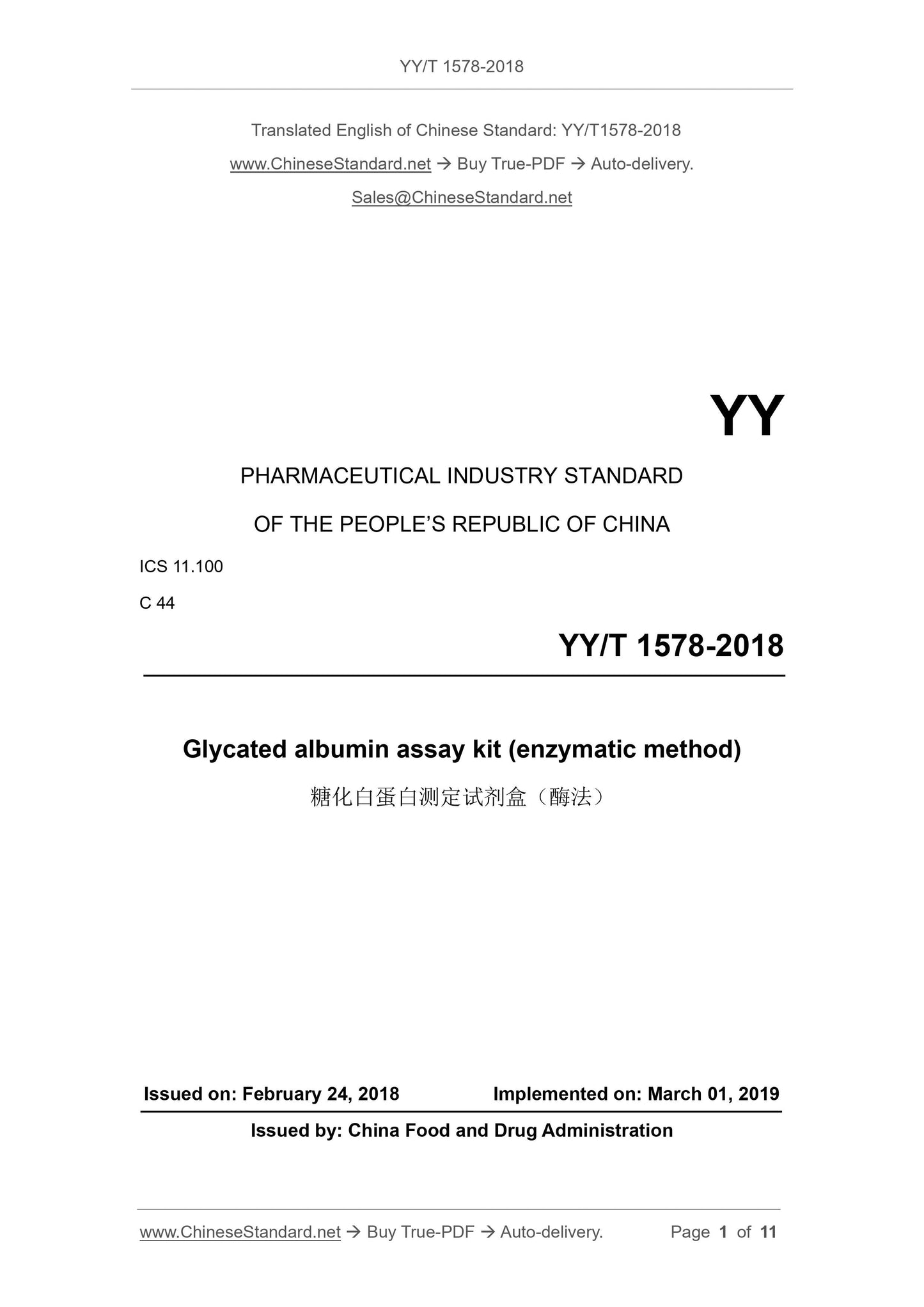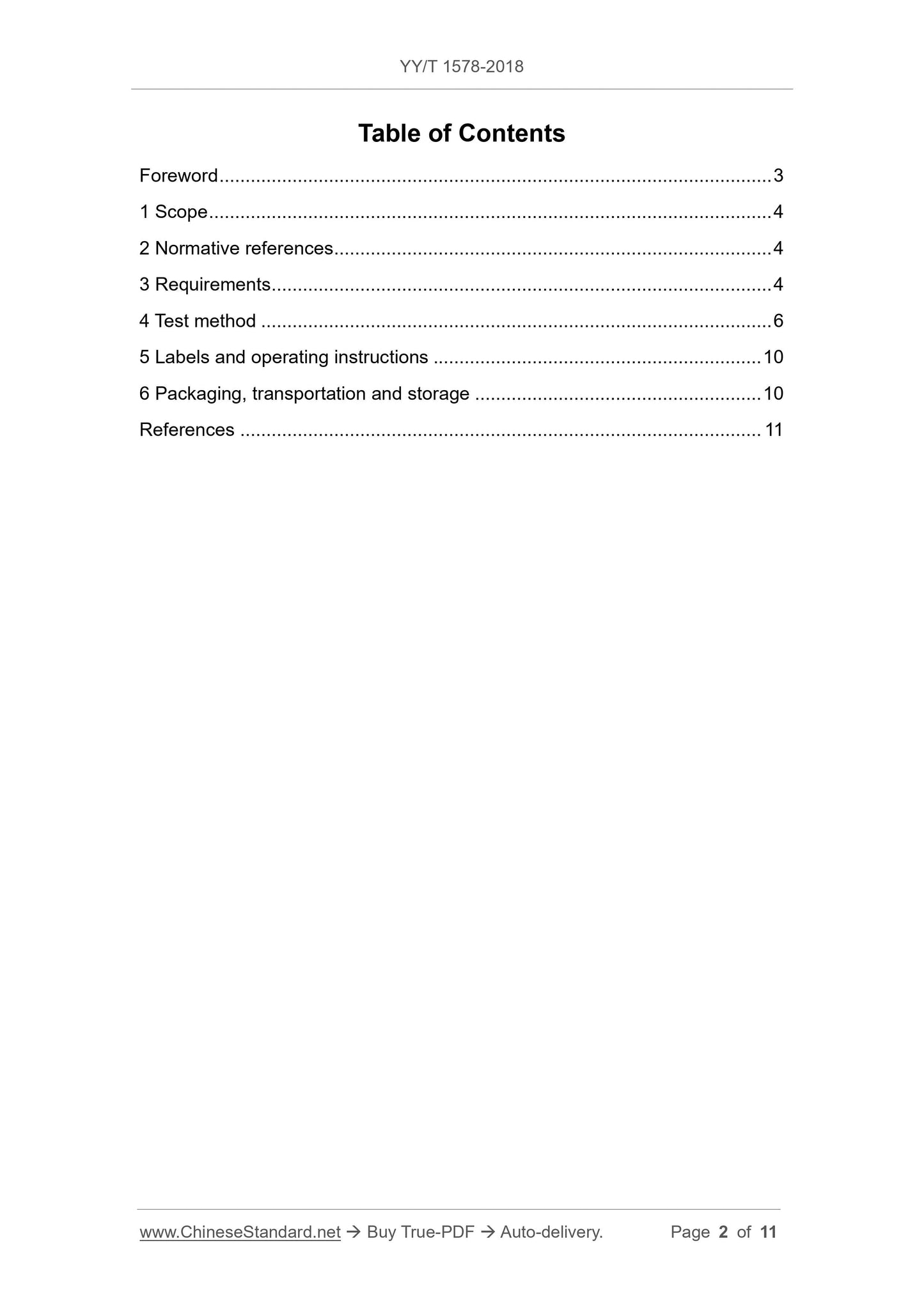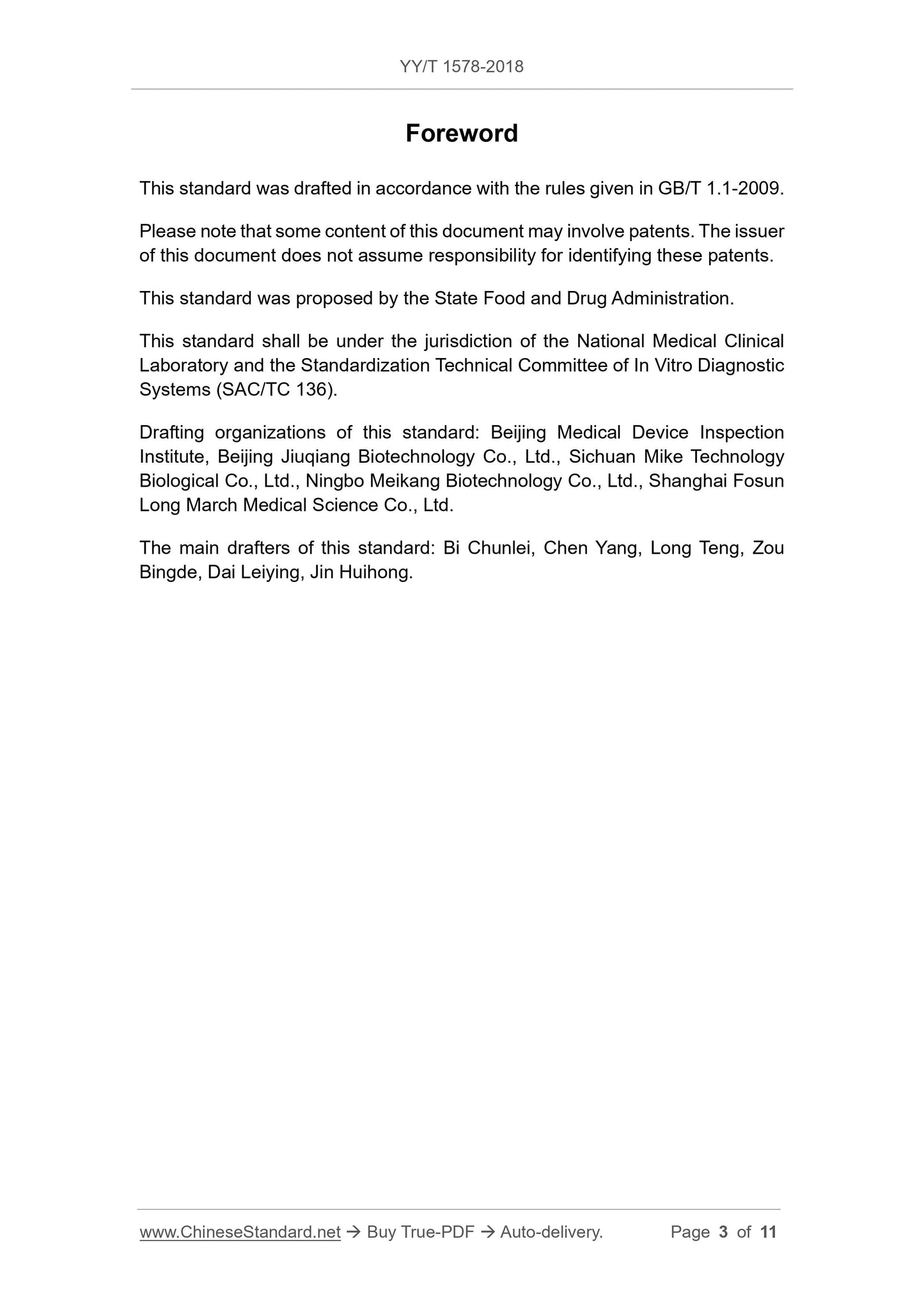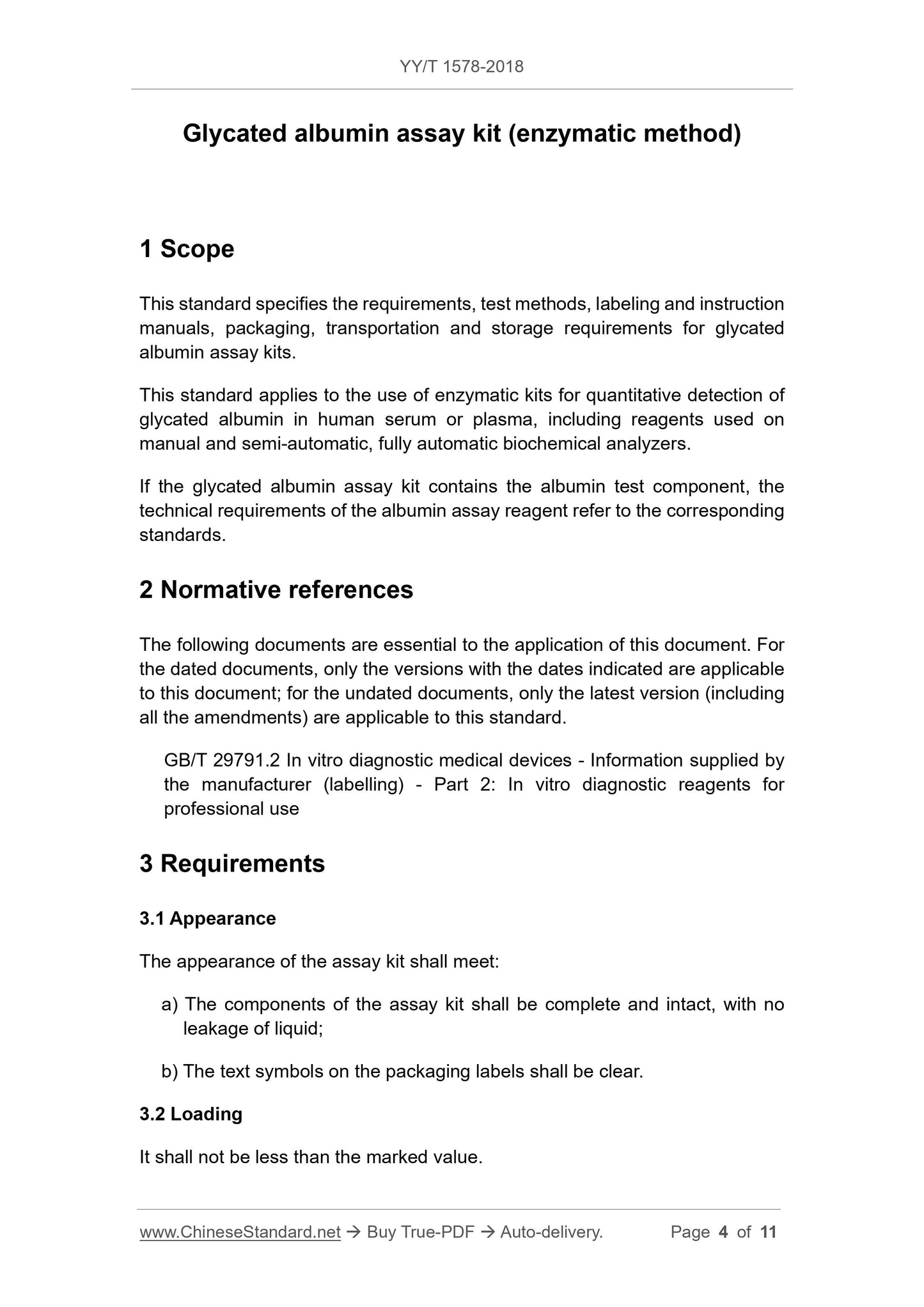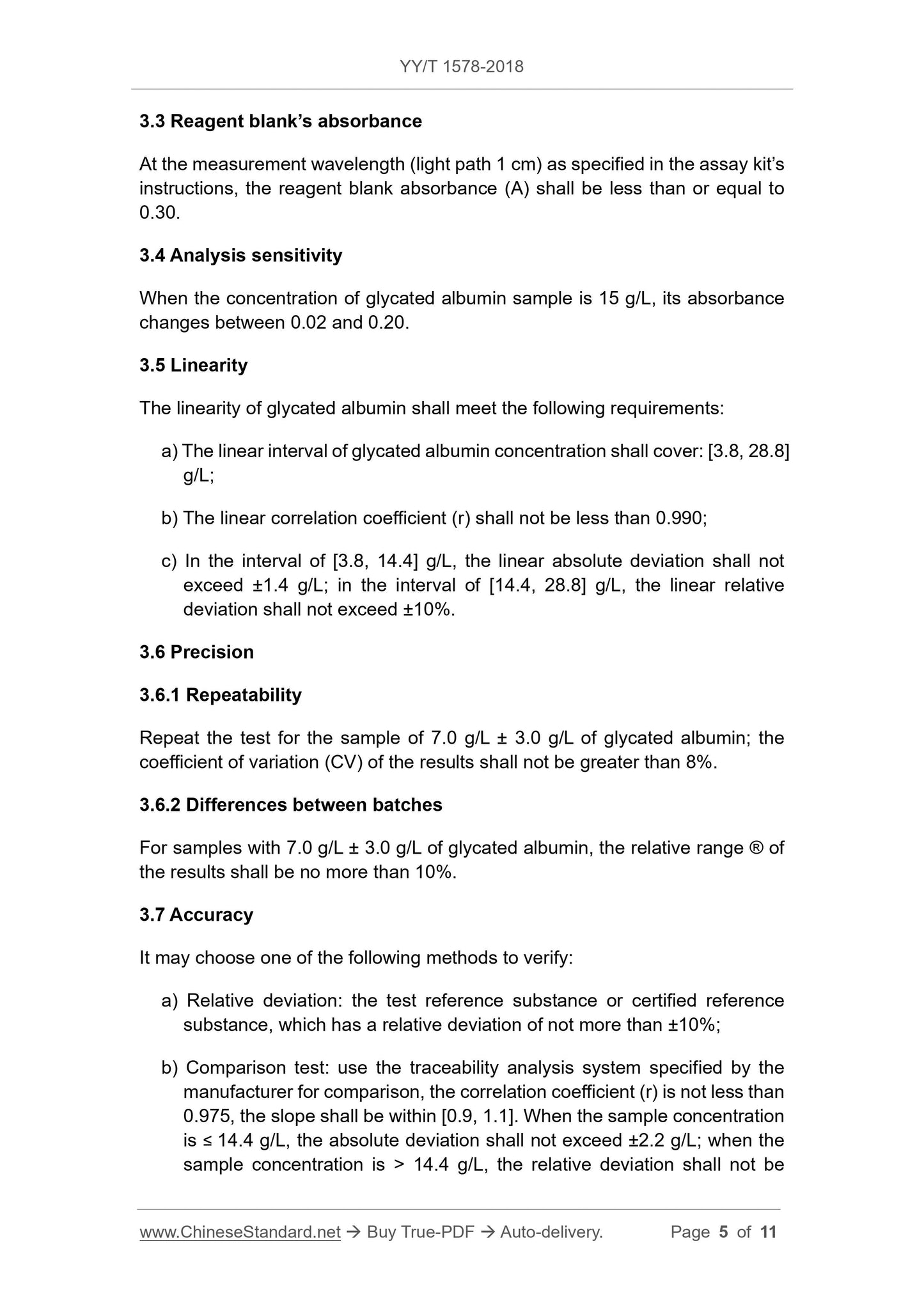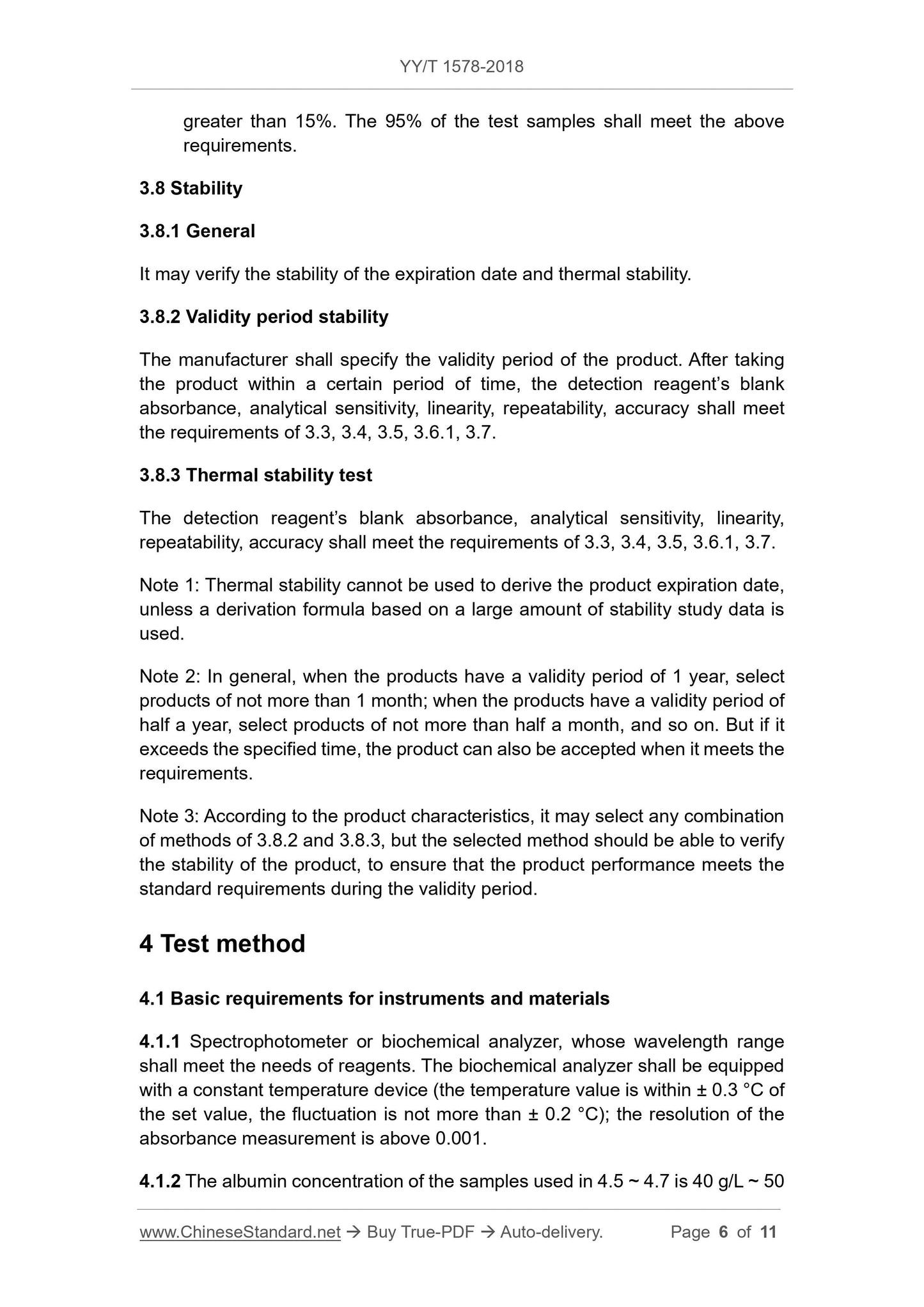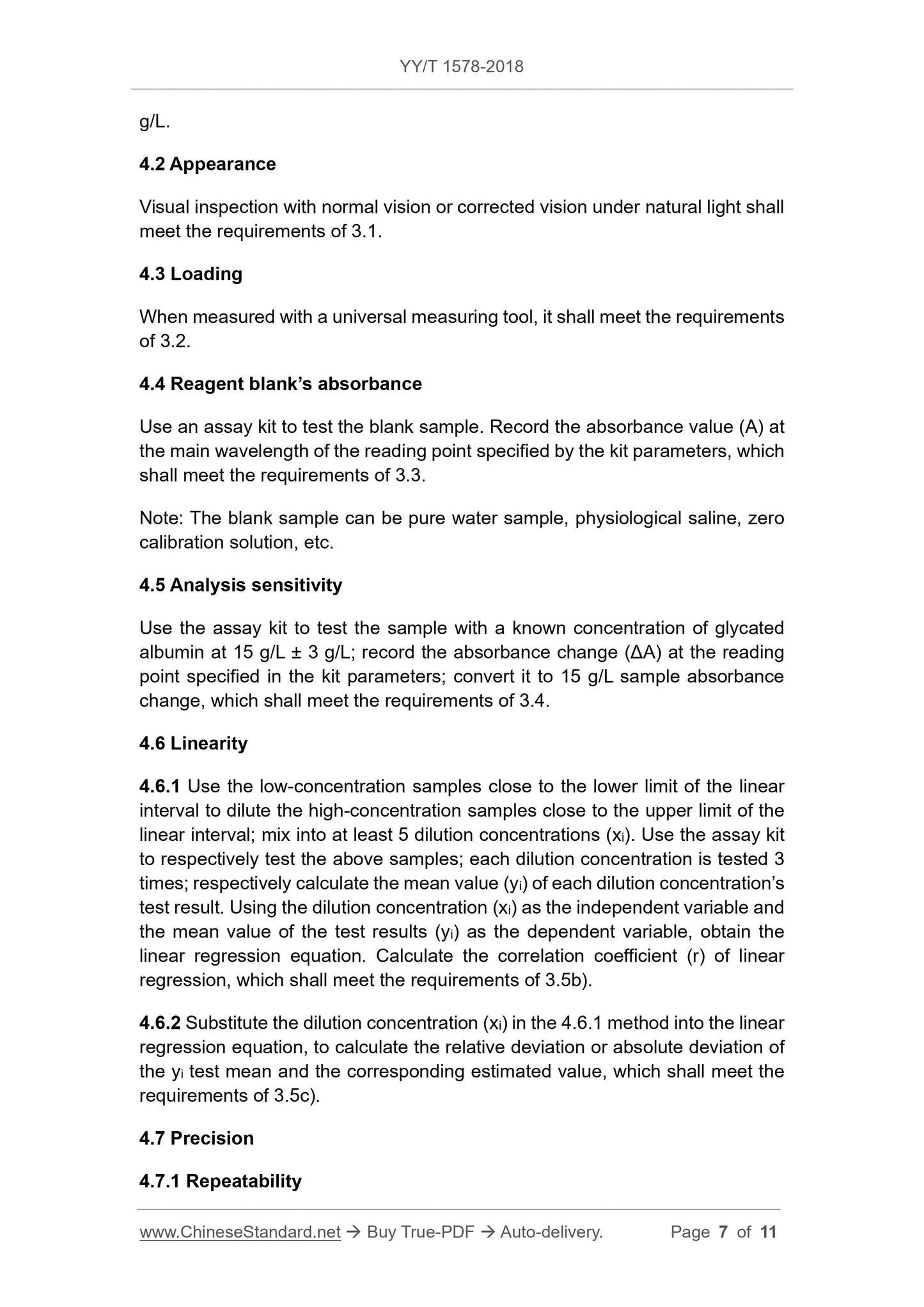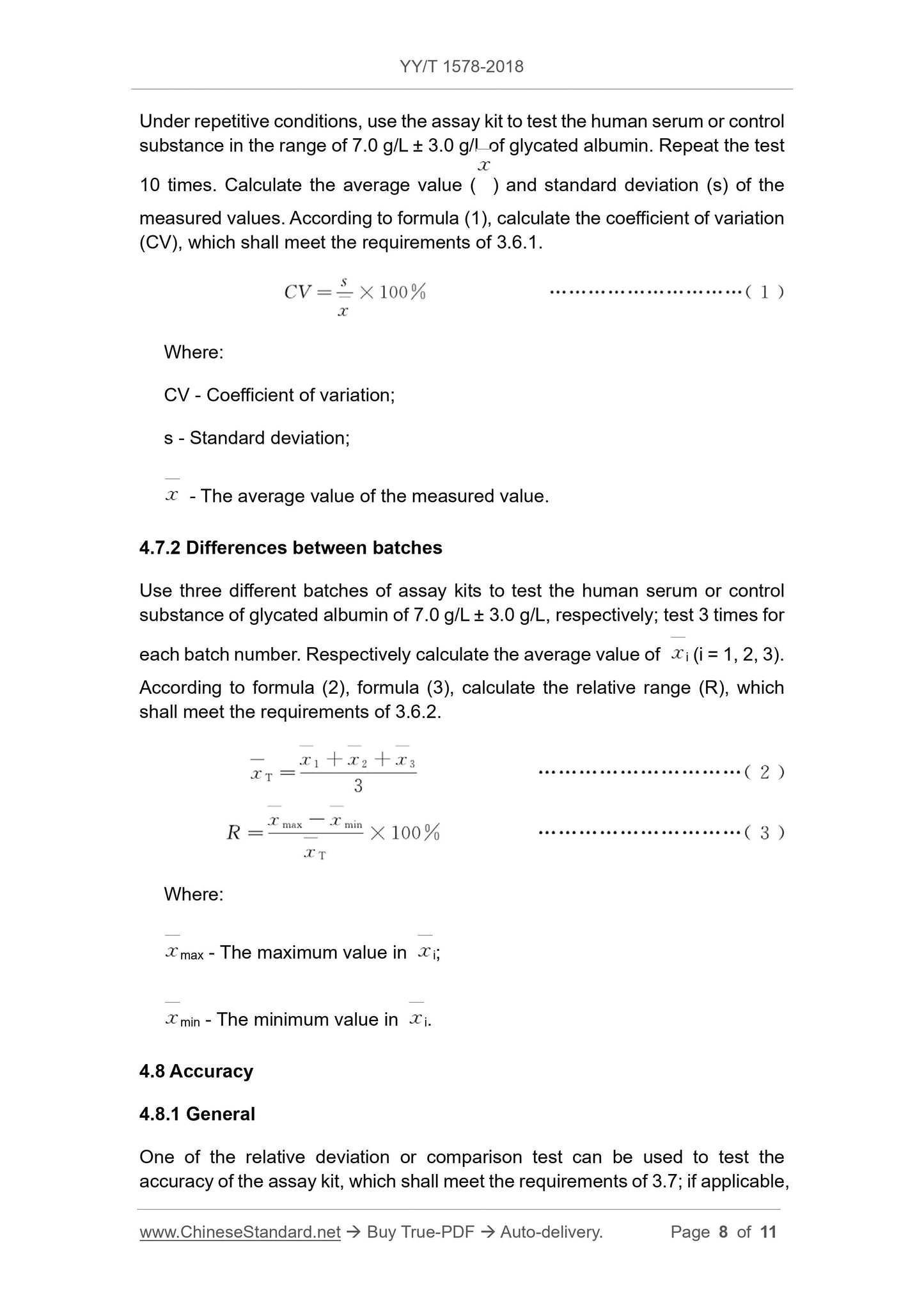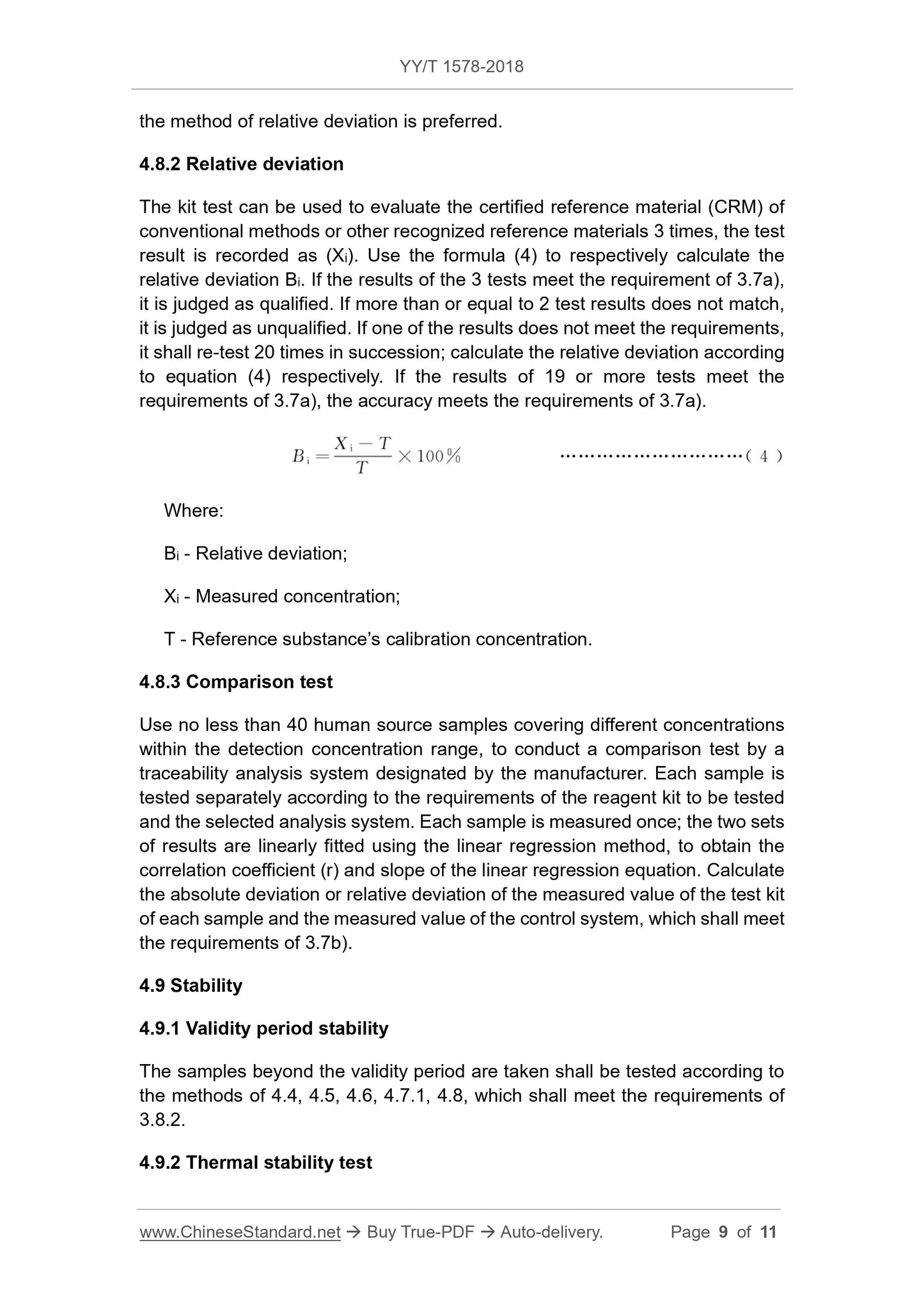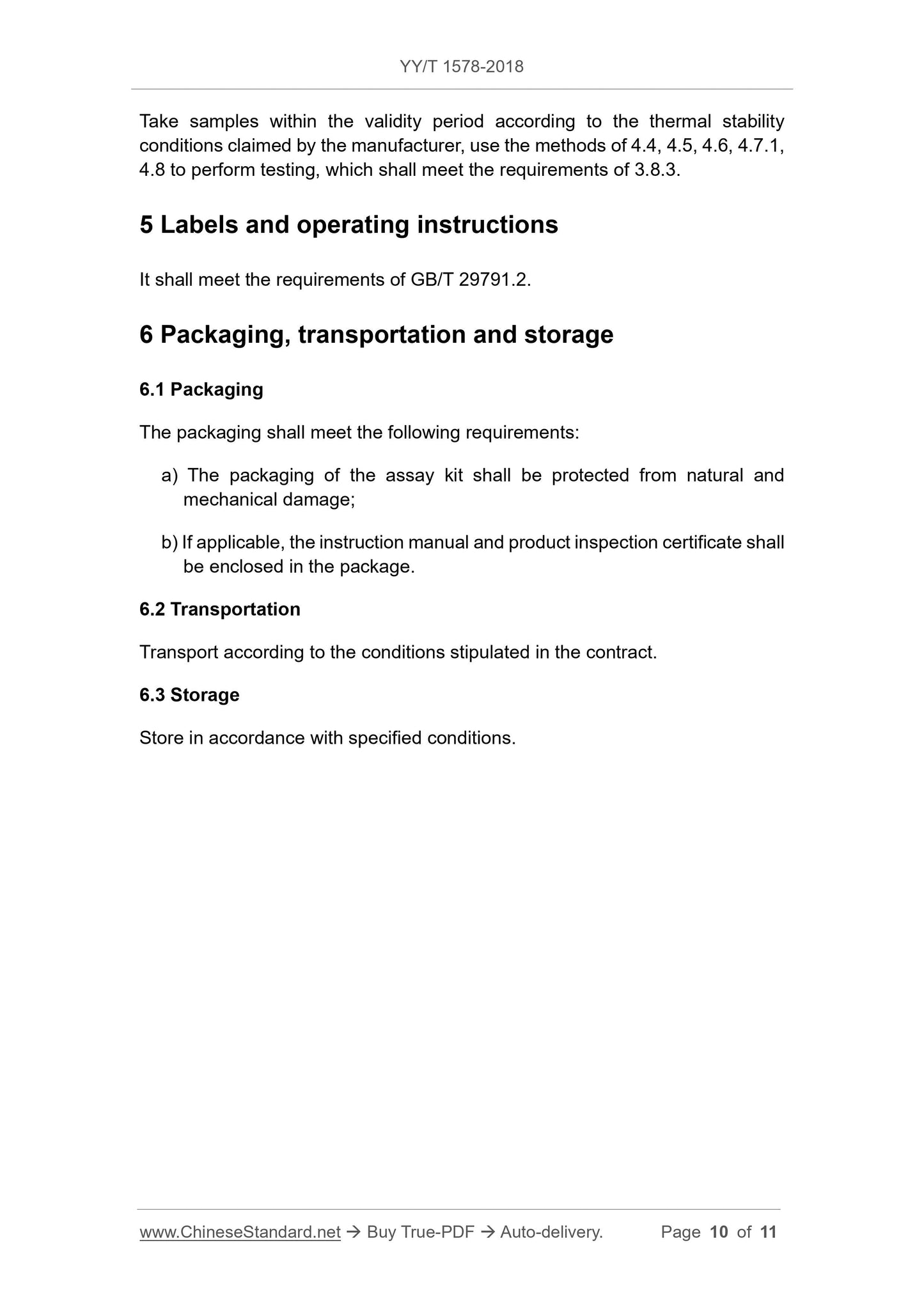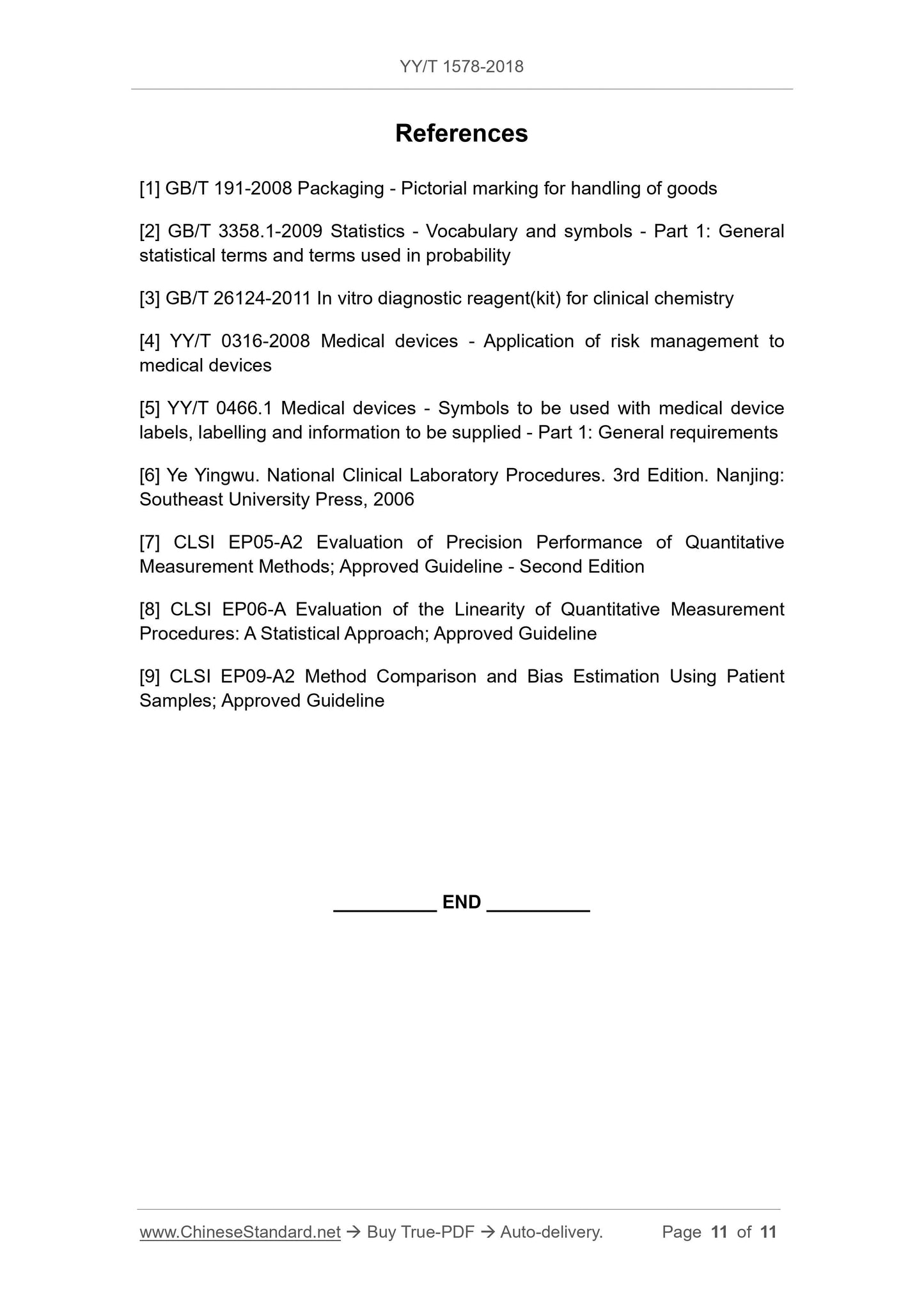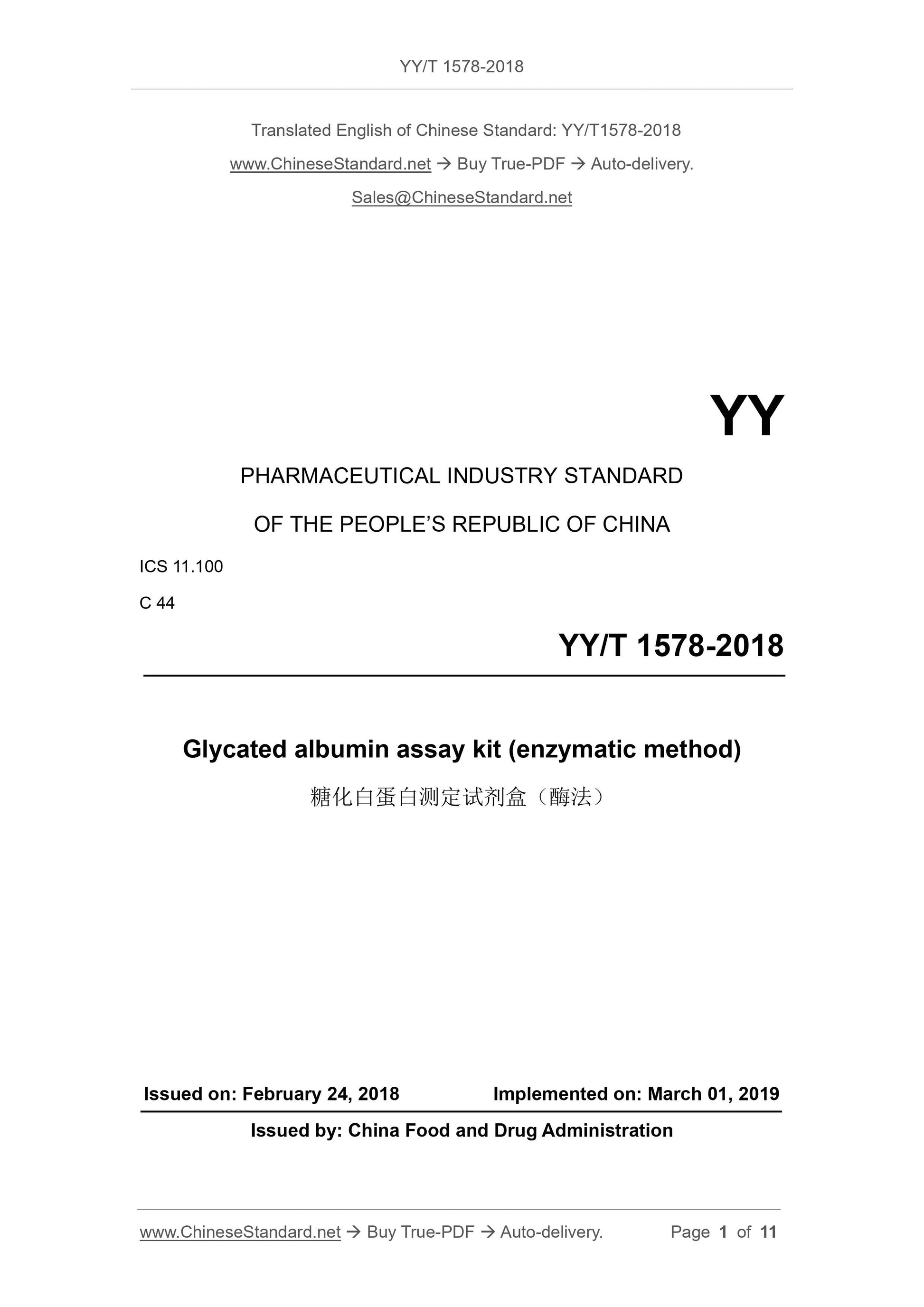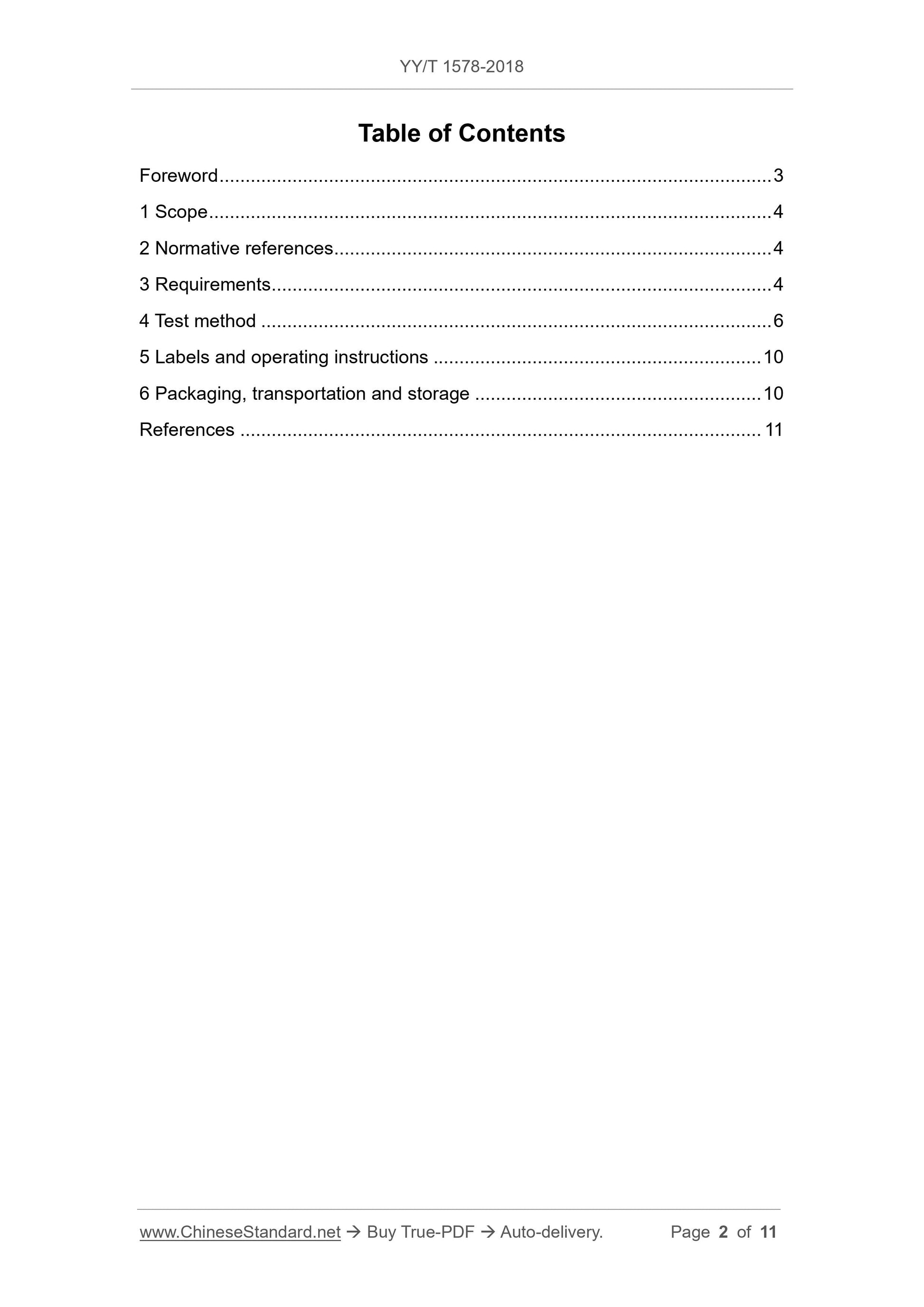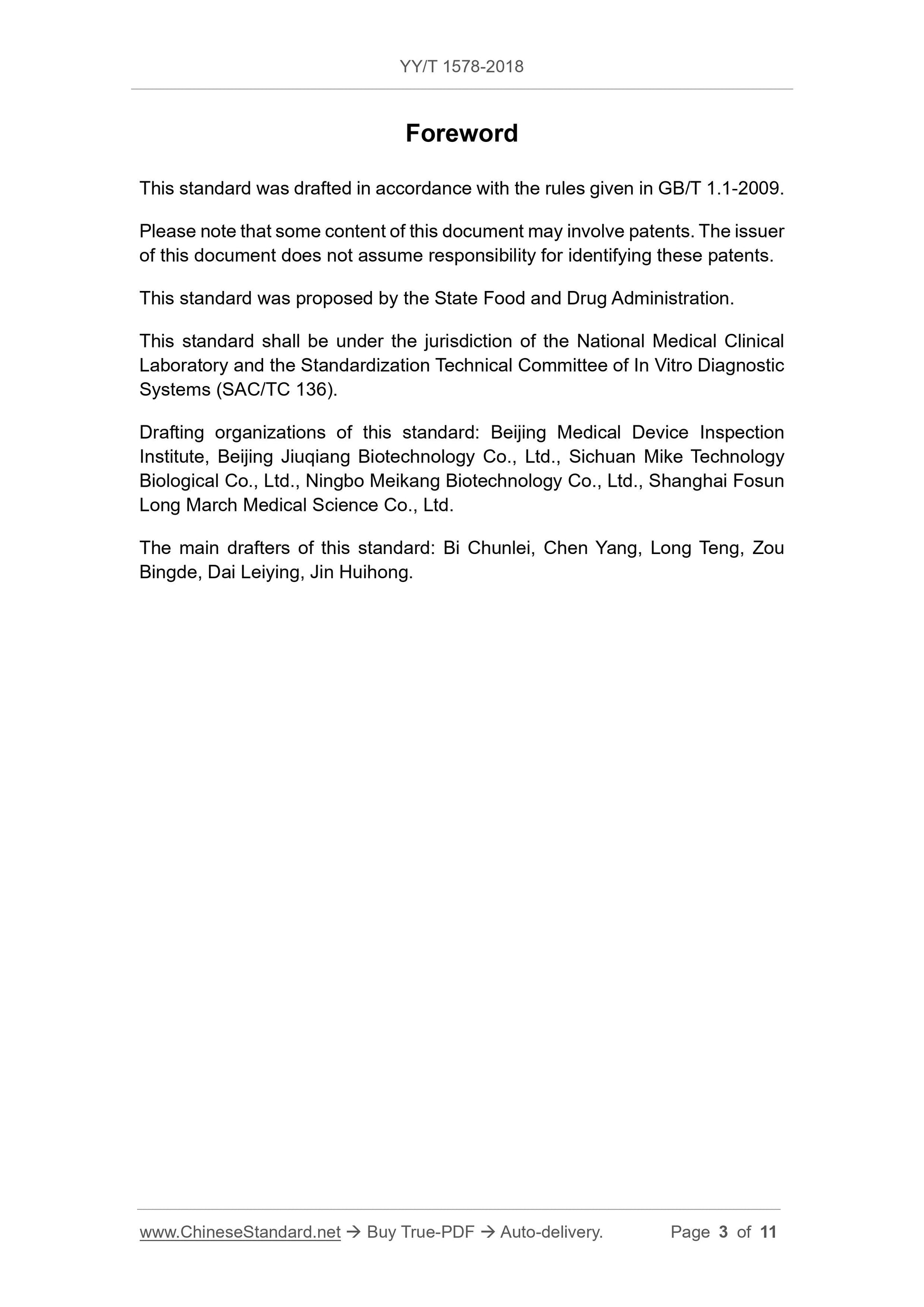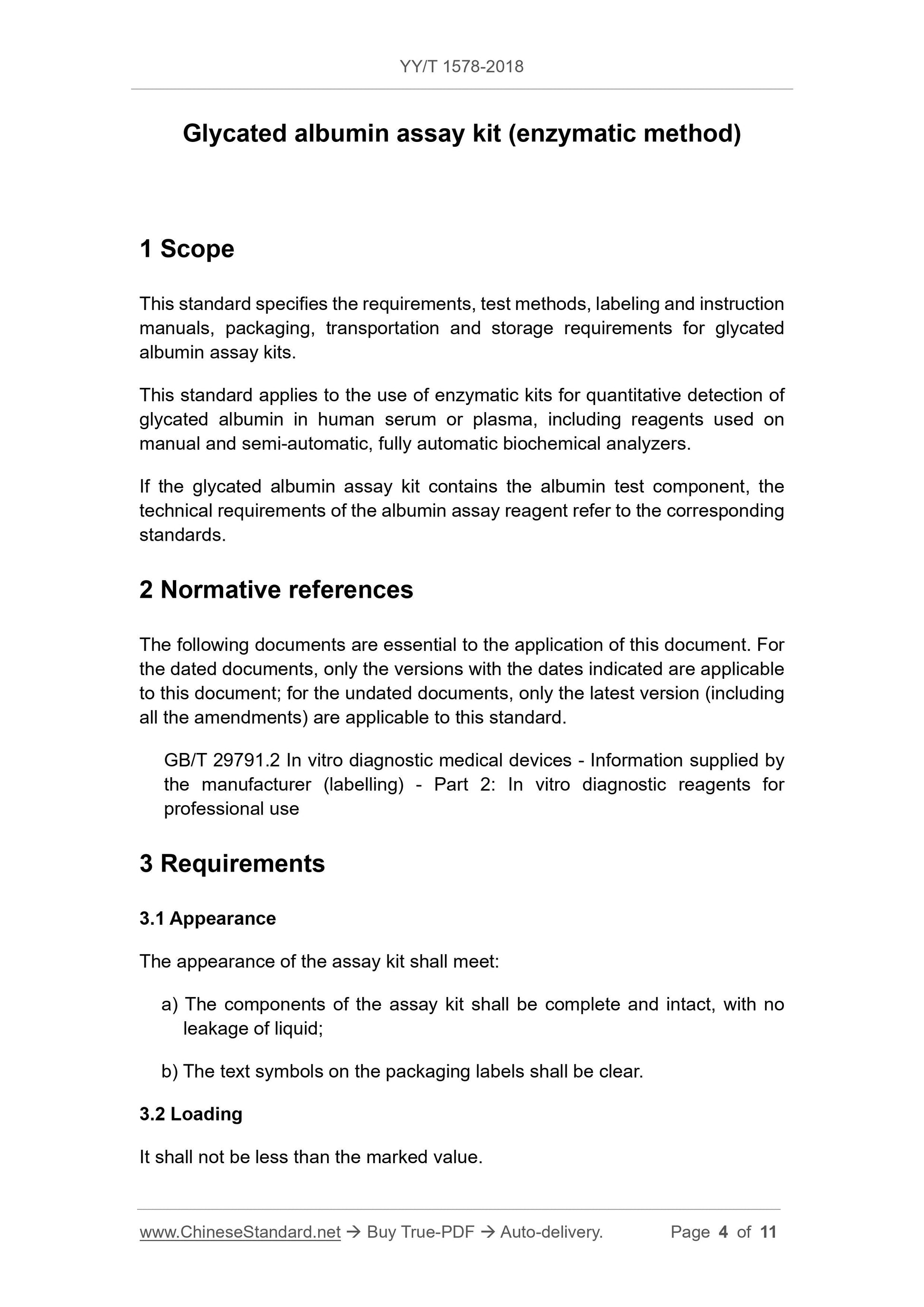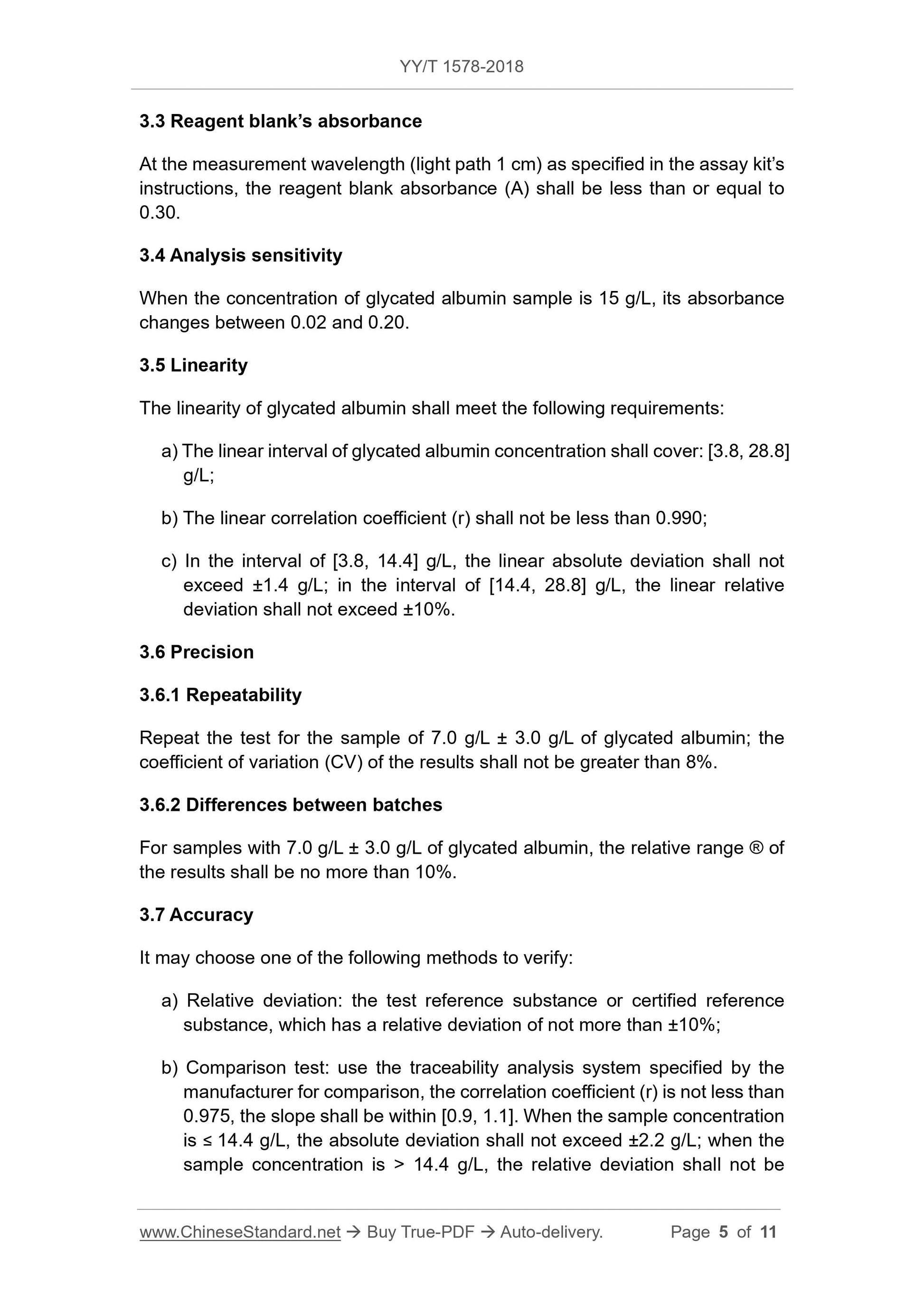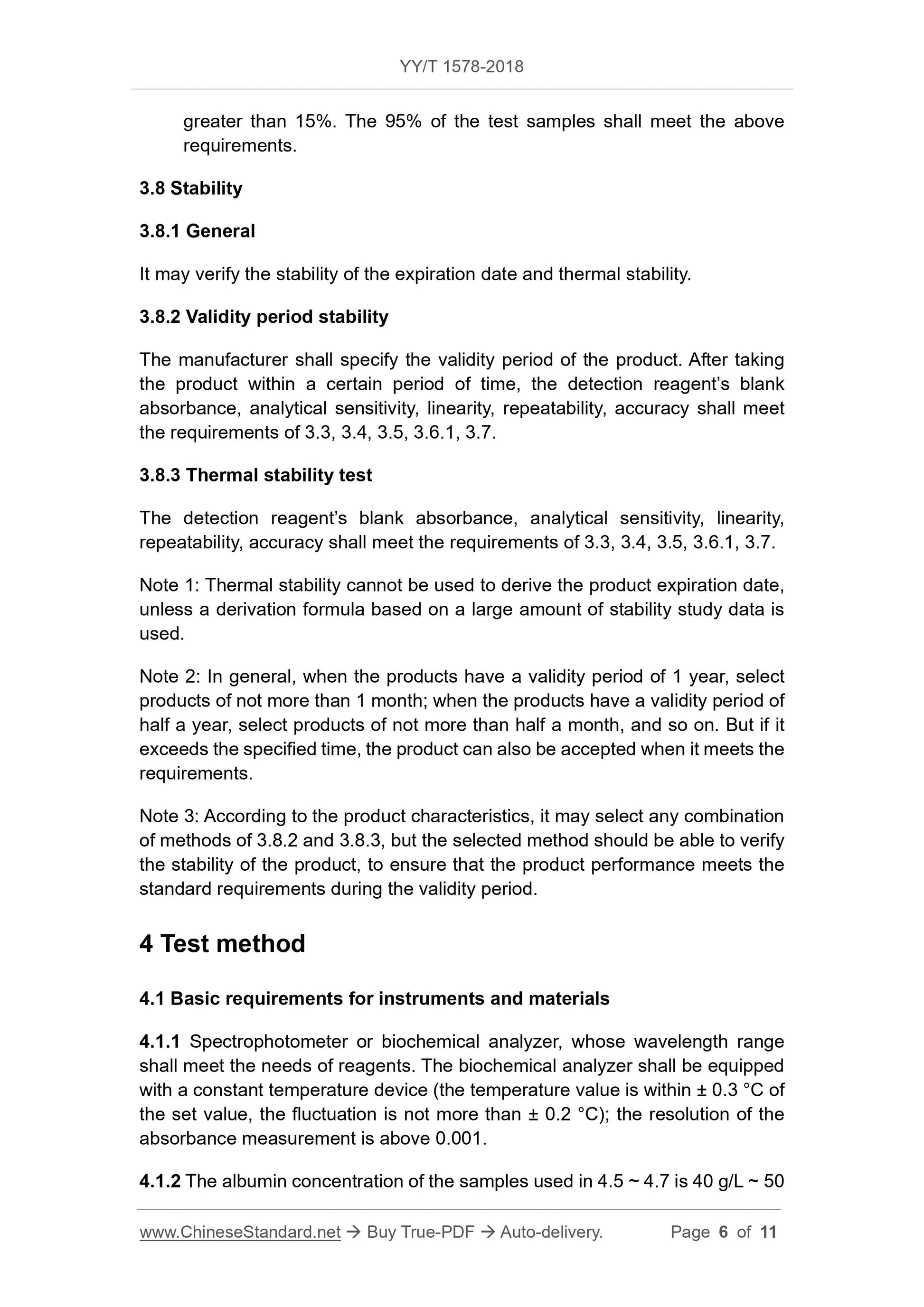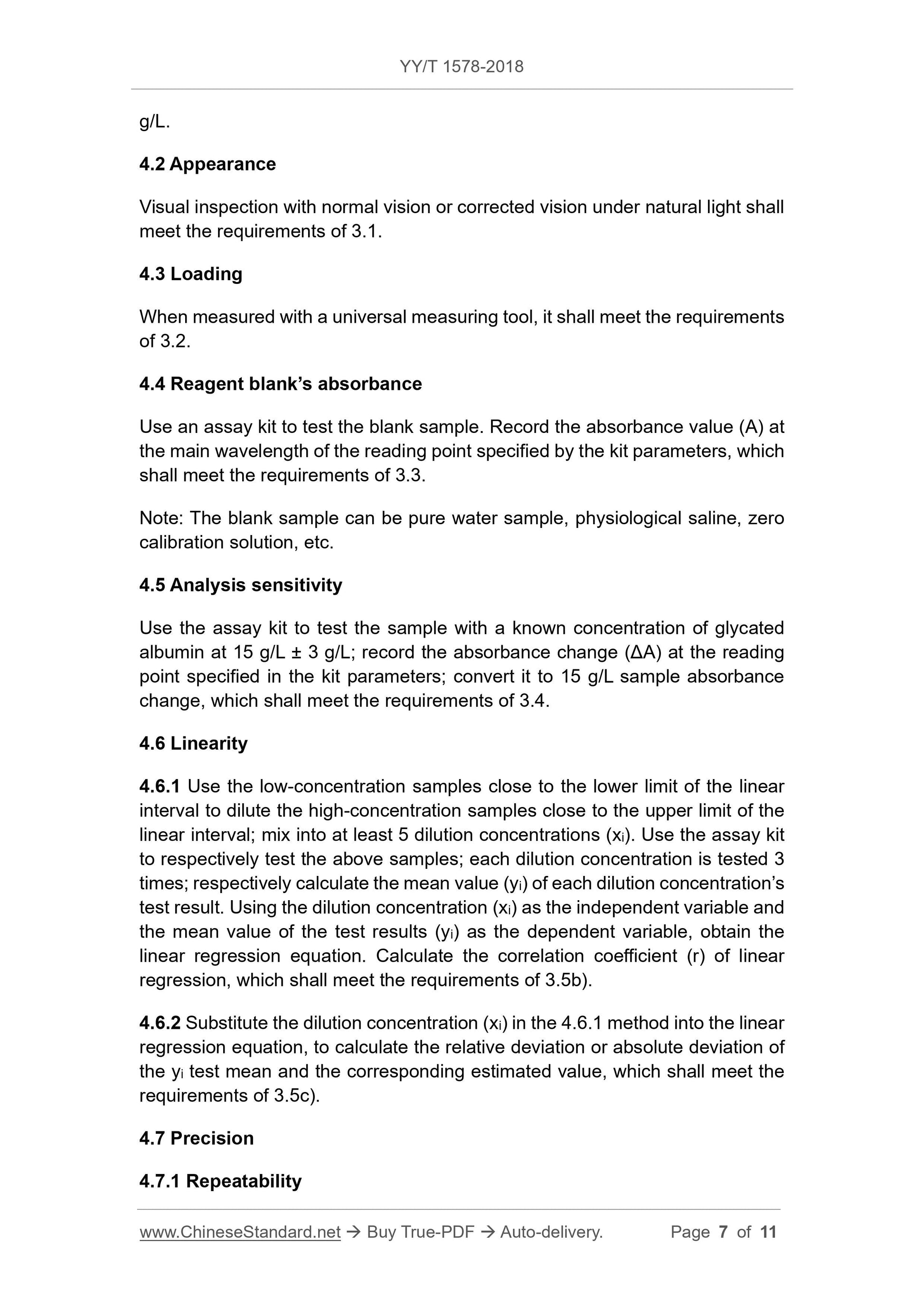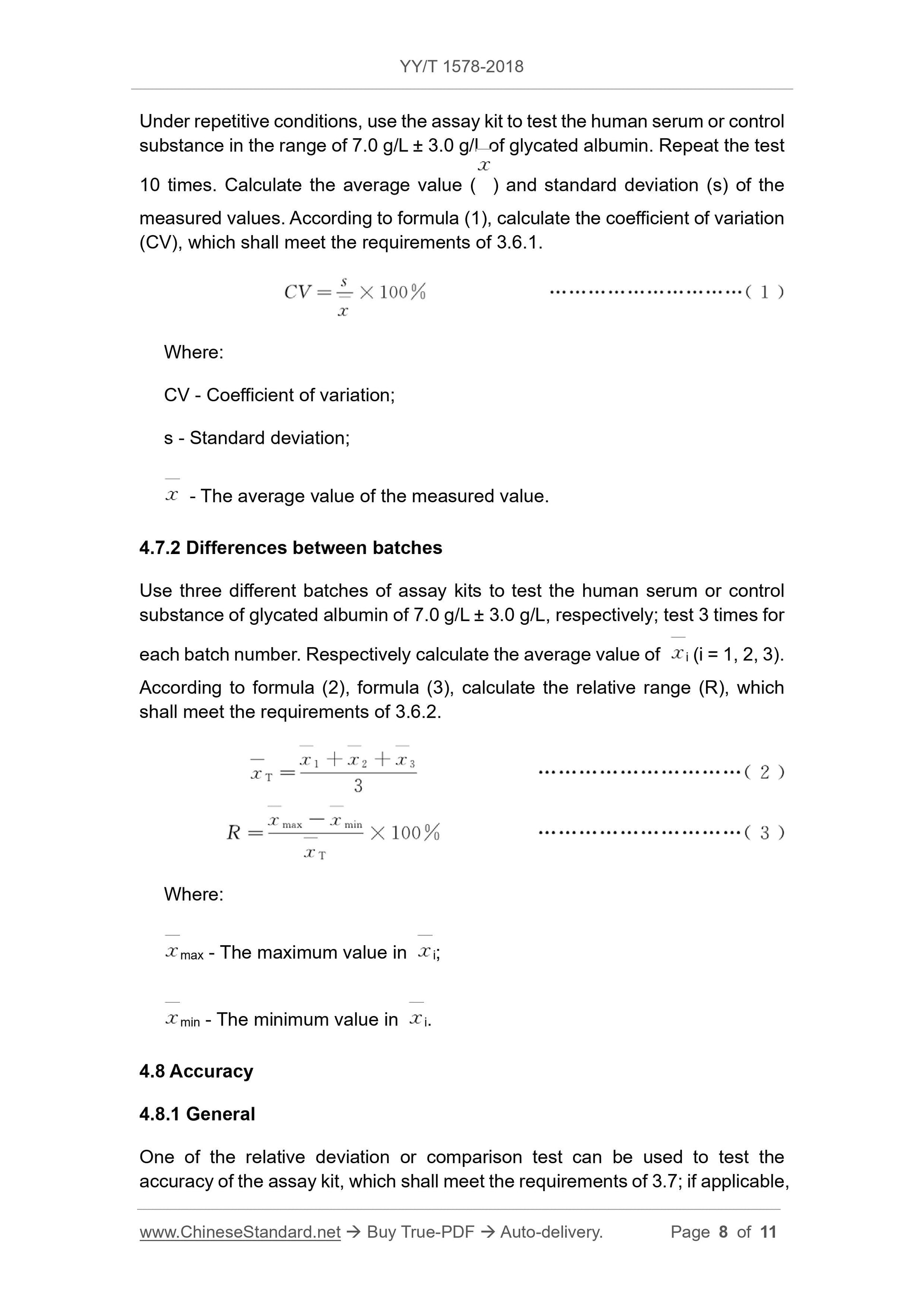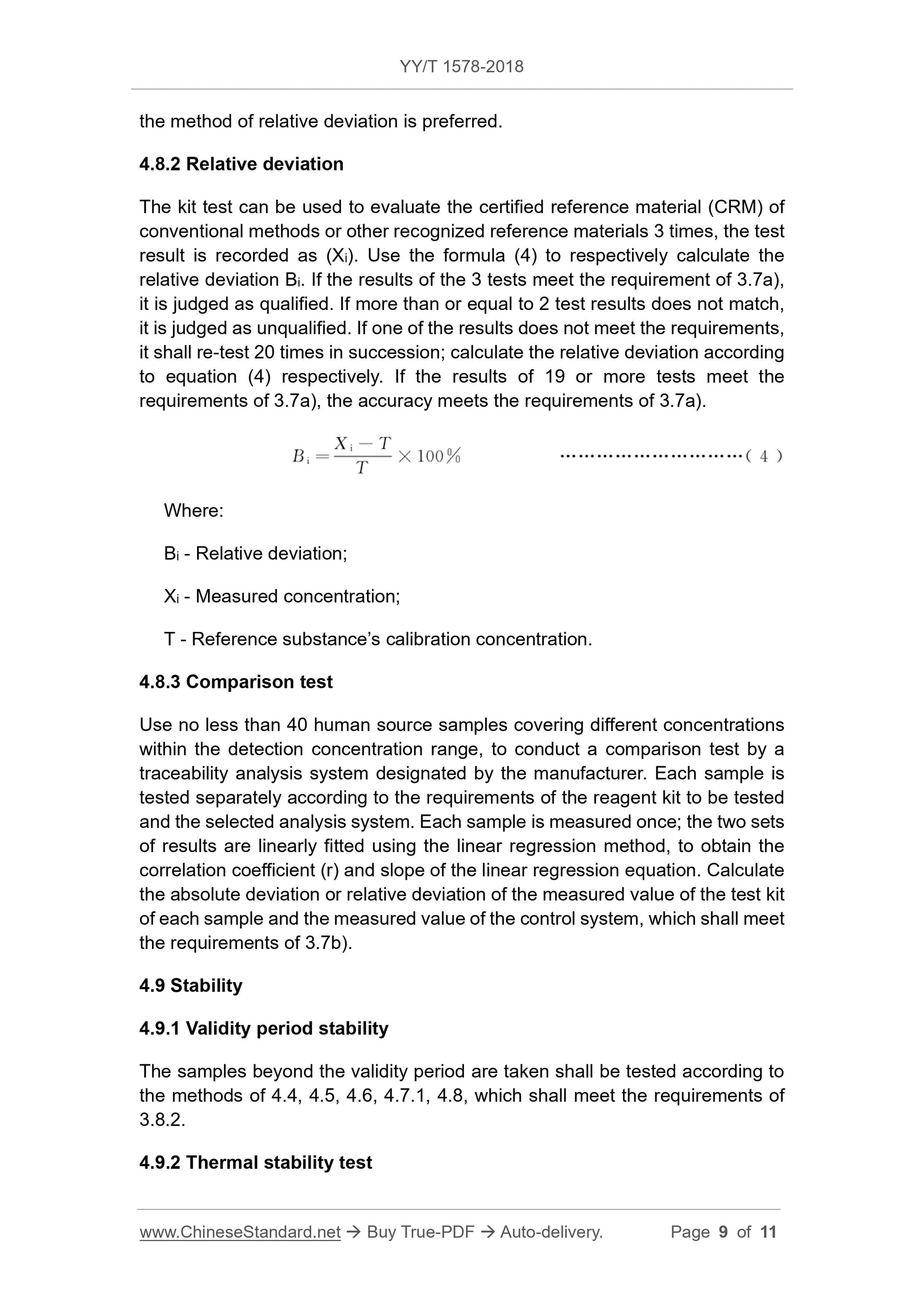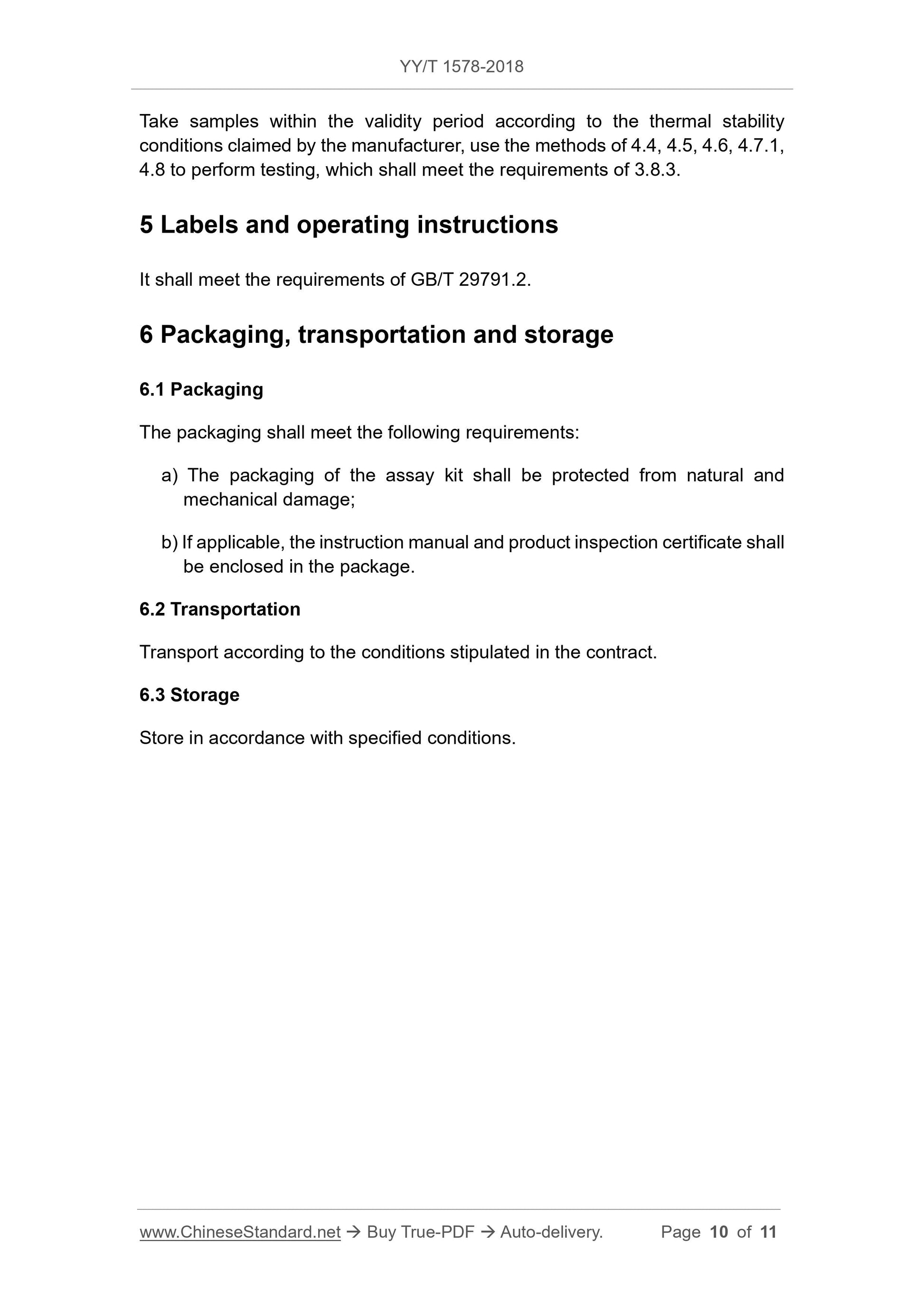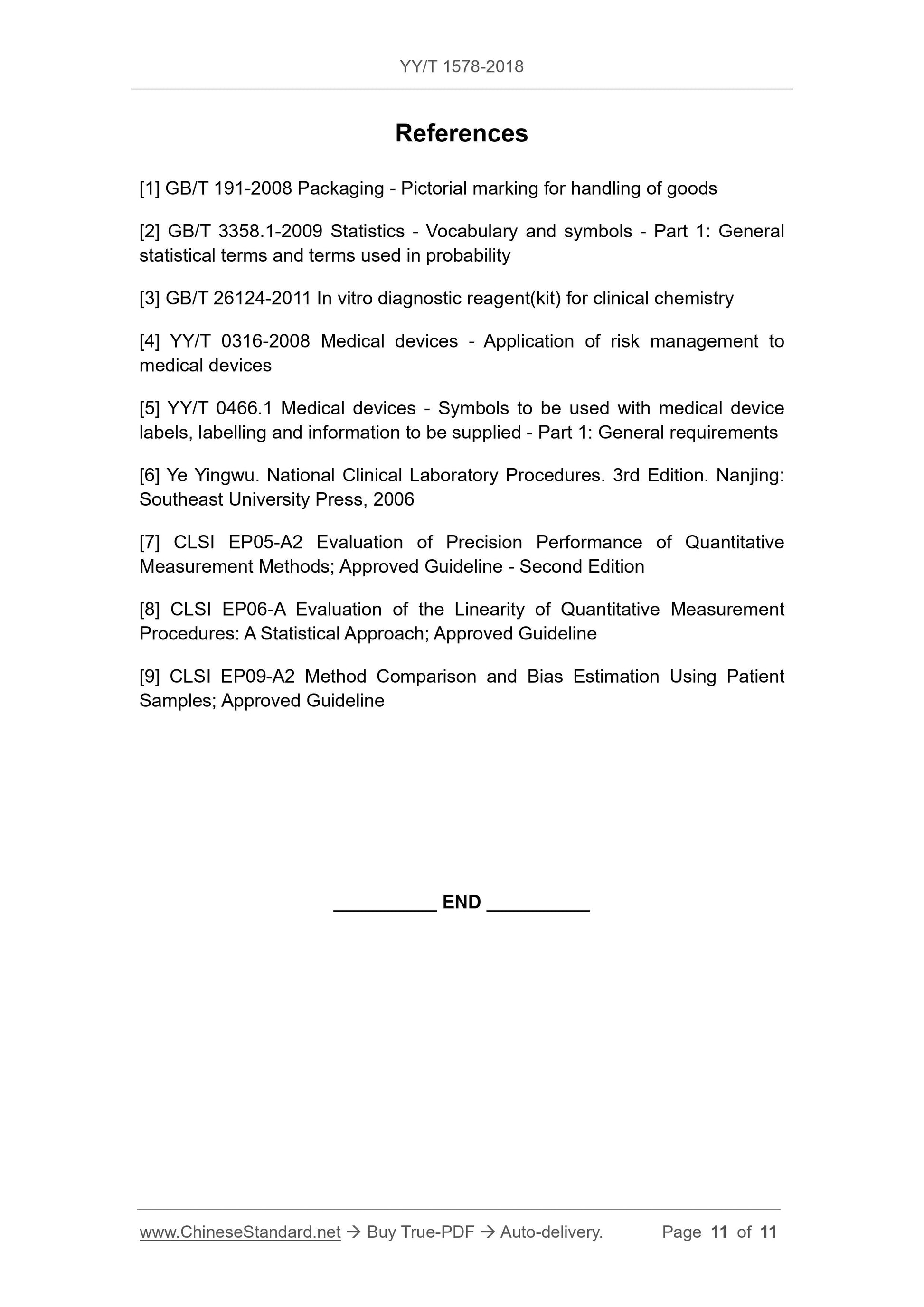1
/
of
11
PayPal, credit cards. Download editable-PDF & invoice in 1 second!
YY/T 1578-2018 English PDF (YYT1578-2018)
YY/T 1578-2018 English PDF (YYT1578-2018)
Regular price
$130.00 USD
Regular price
Sale price
$130.00 USD
Unit price
/
per
Shipping calculated at checkout.
Couldn't load pickup availability
Delivery: 3 seconds. Download true-PDF + Invoice.
Get QUOTATION in 1-minute: Click YY/T 1578-2018
Historical versions: YY/T 1578-2018
Preview True-PDF (Reload/Scroll if blank)
YY/T 1578-2018: Glycated albumin assay kit(enzymatic method)
YY/T 1578-2018
YY
PHARMACEUTICAL INDUSTRY STANDARD
OF THE PEOPLE’S REPUBLIC OF CHINA
ICS 11.100
C 44
Glycated albumin assay kit (enzymatic method)
ISSUED ON: FEBRUARY 24, 2018
IMPLEMENTED ON: MARCH 01, 2019
Issued by: China Food and Drug Administration
Table of Contents
Foreword ... 3
1 Scope ... 4
2 Normative references ... 4
3 Requirements ... 4
4 Test method ... 6
5 Labels and operating instructions ... 10
6 Packaging, transportation and storage ... 10
References ... 11
Glycated albumin assay kit (enzymatic method)
1 Scope
This standard specifies the requirements, test methods, labeling and instruction
manuals, packaging, transportation and storage requirements for glycated
albumin assay kits.
This standard applies to the use of enzymatic kits for quantitative detection of
glycated albumin in human serum or plasma, including reagents used on
manual and semi-automatic, fully automatic biochemical analyzers.
If the glycated albumin assay kit contains the albumin test component, the
technical requirements of the albumin assay reagent refer to the corresponding
standards.
2 Normative references
The following documents are essential to the application of this document. For
the dated documents, only the versions with the dates indicated are applicable
to this document; for the undated documents, only the latest version (including
all the amendments) are applicable to this standard.
GB/T 29791.2 In vitro diagnostic medical devices - Information supplied by
the manufacturer (labelling) - Part 2: In vitro diagnostic reagents for
professional use
3 Requirements
3.1 Appearance
The appearance of the assay kit shall meet:
a) The components of the assay kit shall be complete and intact, with no
leakage of liquid;
b) The text symbols on the packaging labels shall be clear.
3.2 Loading
It shall not be less than the marked value.
greater than 15%. The 95% of the test samples shall meet the above
requirements.
3.8 Stability
3.8.1 General
It may verify the stability of the expiration date and thermal stability.
3.8.2 Validity period stability
The manufacturer shall specify the validity period of the product. After taking
the product within a certain period of time, the detection reagent’s blank
absorbance, analytical sensitivity, linearity, repeatability, accuracy shall meet
the requirements of 3.3, 3.4, 3.5, 3.6.1, 3.7.
3.8.3 Thermal stability test
The detection reagent’s blank absorbance, analytical sensitivity, linearity,
repeatability, accuracy shall meet the requirements of 3.3, 3.4, 3.5, 3.6.1, 3.7.
Note 1: Thermal stability cannot be used to derive the product expiration date,
unless a derivation formula based on a large amount of stability study data is
used.
Note 2: In general, when the products have a validity period of 1 year, select
products of not more than 1 month; when the products have a validity period of
half a year, select products of not more than half a month, and so on. But if it
exceeds the specified time, the product can also be accepted when it meets the
requirements.
Note 3: According to the product characteristics, it may select any combination
of methods of 3.8.2 and 3.8.3, but the selected method should be able to verify
the stability of the product, to ensure that the product performance meets the
standard requirements during the validity period.
4 Test method
4.1 Basic requirements for instruments and materials
4.1.1 Spectrophotometer or biochemical analyzer, whose wavelength range
shall meet the needs of reagents. The biochemical analyzer shall be equipped
with a constant temperature device (the temperature value is within ± 0.3 °C of
the set value, the fluctuation is not more than ± 0.2 °C); the resolution of the
absorbance measurement is above 0.001.
4.1.2 The albumin concentration of the samples used in 4.5 ~ 4.7 is 40 g/L ~ 50
the method of relative deviation is preferred.
4.8.2 Relative deviation
The kit test can be used to evaluate the certified reference material (CRM) of
conventional methods or other recognized reference materials 3 times, the test
result is recorded as (Xi). Use the formula (4) to respectively calculate the
relative deviation Bi. If the results of the 3 tests meet the requirement of 3.7a),
it is judged as qualified. If more than or equal to 2 test results does not match,
it is judged as unqualified. If one of the results does not meet the requirements,
it shall re-test 20 times in succession; calculate the relative deviation according
to equation (4) respectively. If the results of 19 or more tests meet the
requirements of 3.7a), the accuracy meets the requirements of 3.7a).
Where:
Bi - Relative deviation;
Xi - Measured concentration;
T - Reference substance’s calibration concentration.
4.8.3 Comparison test
Use no less than 40 human source samples covering different concentrations
within the detection concentration range, to conduct a comparison test by a
traceability analysis system designated by the manufacturer. Each sample is
tested separately according to the requirements of the reagent kit to be tested
and the selected analysis system. Each sample is measured once; the two sets
of results are linearly fitted using the linear regression method, to obtain the
correlation coefficient (r) and slope of the linear regression equation. Calculate
the absolute deviation or relative deviation of the measured value of the test kit
of each sample and the measured value of the control system, which shall meet
the requirements of 3.7b).
4.9 Stability
4.9.1 Validity period stability
The samples beyond the validity period are taken shall be tested according to
the methods of 4.4, 4.5, 4.6, 4.7.1, 4.8, which shall meet the requirements of
3.8.2.
4.9.2 Thermal stability test
Get QUOTATION in 1-minute: Click YY/T 1578-2018
Historical versions: YY/T 1578-2018
Preview True-PDF (Reload/Scroll if blank)
YY/T 1578-2018: Glycated albumin assay kit(enzymatic method)
YY/T 1578-2018
YY
PHARMACEUTICAL INDUSTRY STANDARD
OF THE PEOPLE’S REPUBLIC OF CHINA
ICS 11.100
C 44
Glycated albumin assay kit (enzymatic method)
ISSUED ON: FEBRUARY 24, 2018
IMPLEMENTED ON: MARCH 01, 2019
Issued by: China Food and Drug Administration
Table of Contents
Foreword ... 3
1 Scope ... 4
2 Normative references ... 4
3 Requirements ... 4
4 Test method ... 6
5 Labels and operating instructions ... 10
6 Packaging, transportation and storage ... 10
References ... 11
Glycated albumin assay kit (enzymatic method)
1 Scope
This standard specifies the requirements, test methods, labeling and instruction
manuals, packaging, transportation and storage requirements for glycated
albumin assay kits.
This standard applies to the use of enzymatic kits for quantitative detection of
glycated albumin in human serum or plasma, including reagents used on
manual and semi-automatic, fully automatic biochemical analyzers.
If the glycated albumin assay kit contains the albumin test component, the
technical requirements of the albumin assay reagent refer to the corresponding
standards.
2 Normative references
The following documents are essential to the application of this document. For
the dated documents, only the versions with the dates indicated are applicable
to this document; for the undated documents, only the latest version (including
all the amendments) are applicable to this standard.
GB/T 29791.2 In vitro diagnostic medical devices - Information supplied by
the manufacturer (labelling) - Part 2: In vitro diagnostic reagents for
professional use
3 Requirements
3.1 Appearance
The appearance of the assay kit shall meet:
a) The components of the assay kit shall be complete and intact, with no
leakage of liquid;
b) The text symbols on the packaging labels shall be clear.
3.2 Loading
It shall not be less than the marked value.
greater than 15%. The 95% of the test samples shall meet the above
requirements.
3.8 Stability
3.8.1 General
It may verify the stability of the expiration date and thermal stability.
3.8.2 Validity period stability
The manufacturer shall specify the validity period of the product. After taking
the product within a certain period of time, the detection reagent’s blank
absorbance, analytical sensitivity, linearity, repeatability, accuracy shall meet
the requirements of 3.3, 3.4, 3.5, 3.6.1, 3.7.
3.8.3 Thermal stability test
The detection reagent’s blank absorbance, analytical sensitivity, linearity,
repeatability, accuracy shall meet the requirements of 3.3, 3.4, 3.5, 3.6.1, 3.7.
Note 1: Thermal stability cannot be used to derive the product expiration date,
unless a derivation formula based on a large amount of stability study data is
used.
Note 2: In general, when the products have a validity period of 1 year, select
products of not more than 1 month; when the products have a validity period of
half a year, select products of not more than half a month, and so on. But if it
exceeds the specified time, the product can also be accepted when it meets the
requirements.
Note 3: According to the product characteristics, it may select any combination
of methods of 3.8.2 and 3.8.3, but the selected method should be able to verify
the stability of the product, to ensure that the product performance meets the
standard requirements during the validity period.
4 Test method
4.1 Basic requirements for instruments and materials
4.1.1 Spectrophotometer or biochemical analyzer, whose wavelength range
shall meet the needs of reagents. The biochemical analyzer shall be equipped
with a constant temperature device (the temperature value is within ± 0.3 °C of
the set value, the fluctuation is not more than ± 0.2 °C); the resolution of the
absorbance measurement is above 0.001.
4.1.2 The albumin concentration of the samples used in 4.5 ~ 4.7 is 40 g/L ~ 50
the method of relative deviation is preferred.
4.8.2 Relative deviation
The kit test can be used to evaluate the certified reference material (CRM) of
conventional methods or other recognized reference materials 3 times, the test
result is recorded as (Xi). Use the formula (4) to respectively calculate the
relative deviation Bi. If the results of the 3 tests meet the requirement of 3.7a),
it is judged as qualified. If more than or equal to 2 test results does not match,
it is judged as unqualified. If one of the results does not meet the requirements,
it shall re-test 20 times in succession; calculate the relative deviation according
to equation (4) respectively. If the results of 19 or more tests meet the
requirements of 3.7a), the accuracy meets the requirements of 3.7a).
Where:
Bi - Relative deviation;
Xi - Measured concentration;
T - Reference substance’s calibration concentration.
4.8.3 Comparison test
Use no less than 40 human source samples covering different concentrations
within the detection concentration range, to conduct a comparison test by a
traceability analysis system designated by the manufacturer. Each sample is
tested separately according to the requirements of the reagent kit to be tested
and the selected analysis system. Each sample is measured once; the two sets
of results are linearly fitted using the linear regression method, to obtain the
correlation coefficient (r) and slope of the linear regression equation. Calculate
the absolute deviation or relative deviation of the measured value of the test kit
of each sample and the measured value of the control system, which shall meet
the requirements of 3.7b).
4.9 Stability
4.9.1 Validity period stability
The samples beyond the validity period are taken shall be tested according to
the methods of 4.4, 4.5, 4.6, 4.7.1, 4.8, which shall meet the requirements of
3.8.2.
4.9.2 Thermal stability test
Share
